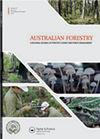Maximising the benefits of trees on farms in Tasmania – a desktop review of investment opportunities to improve farm enterprise productivity, profitability and sustainability
IF 0.9
4区 农林科学
Q3 FORESTRY
引用次数: 2
Abstract
ABSTRACT Demand for forest products in Australia exceeds domestic capacity for local production and supply, resulting in a significant trade deficit in forest products of around AUD 2 billion per year. Domestic demand for forest products is forecast to continue increasing because such products are recognised as more sustainable than many alternative materials used in construction and as feedstocks for other industrial processes. There is increasing pressure to establish more forest plantations to meet this need. Tasmania has around 16% of the national plantation estate and large areas of natural forests that have been protected and conserved. However, there has been a recent decline in the area of the plantation estate, both nationally and in Tasmania, mainly due to increasing competition from agricultural land uses, which provide higher returns and drive land prices higher than can be justified by returns from forestry. This declining trend will be hard to reverse, given that substantial new areas are unlikely to be available for greenfield plantation establishment. A more prospective area for expansion is likely to be the establishment of trees on farms. This option has significant potential because strategic investment in trees on farms can create valuable assets for increasing farm-level sustainability, resilience and profitability. The choice of appropriate species and planting configuration can help improve the financial balance sheet, stocks of natural capital and flows of ecosystem services. Past investment motives for tree-planting in Australia have mainly been based on anticipated returns from timber. If more tree-planting is to be achieved in Tasmania in the future, it will have to be on cleared private land, and the investment motivation will need to encompass the broader values of trees beyond wood production. This review explores the prospective investment opportunities to facilitate greater establishment of trees on farms and sets out seven key areas where research and policy effort is needed: engaging with leading agricultural financial institutions; engaging with institutional investors; engaging with grower organisations around ‘zero carbon’ and ‘nature positive’ branding; research to support the better quantification and adoption of natural capital and its financial benefits; encouraging joint ventures between the industrial plantation sector and farmers; better monetising the carbon sequestration by trees; and the reinvigoration of social capital around growing trees.最大限度地提高塔斯马尼亚州农场树木的效益——对提高农场企业生产力、盈利能力和可持续性的投资机会的桌面审查
摘要:澳大利亚对森林产品的需求超过了当地生产和供应的国内能力,导致每年约20亿澳元的森林产品贸易逆差。国内对森林产品的需求预计将继续增加,因为这些产品被认为比建筑中使用的许多替代材料更具可持续性,并且是其他工业过程的原料。建立更多的森林种植园以满足这一需求的压力越来越大。塔斯马尼亚州拥有约16%的国家种植园和大片受到保护和保护的天然林。然而,最近全国和塔斯马尼亚州的种植园面积都有所下降,主要是由于农业用地的竞争加剧,农业用地提供了更高的回报,并推动土地价格高于林业回报。这种下降趋势很难扭转,因为大量的新区域不太可能用于绿地种植。一个更具前景的扩张领域可能是在农场种植树木。这一选择具有巨大的潜力,因为对农场树木的战略投资可以为提高农场层面的可持续性、韧性和盈利能力创造宝贵的资产。选择适当的物种和种植配置有助于改善财务资产负债表、自然资本存量和生态系统服务的流动。澳大利亚过去的植树投资动机主要基于木材的预期回报。如果未来要在塔斯马尼亚州实现更多的植树,就必须在清理过的私人土地上进行,投资动机需要包括树木在木材生产之外的更广泛价值。这篇综述探讨了促进在农场更多种植树木的潜在投资机会,并提出了需要研究和政策努力的七个关键领域:与领先的农业金融机构合作;与机构投资者接触;围绕“零碳”和“自然积极”品牌与种植者组织合作;支持更好地量化和采用自然资本及其财务效益的研究;鼓励工业种植业部门与农民建立合资企业;更好地将树木固碳货币化;以及围绕植树振兴社会资本。
本文章由计算机程序翻译,如有差异,请以英文原文为准。
求助全文
约1分钟内获得全文
求助全文
来源期刊

Australian Forestry
FORESTRY-
CiteScore
3.70
自引率
4.80%
发文量
15
审稿时长
>12 weeks
期刊介绍:
Australian Forestry is published by Taylor & Francis for the Institute of Foresters of Australia (IFA) for scientific, technical, and professional communication relating to forestry in the Asia Pacific.
 求助内容:
求助内容: 应助结果提醒方式:
应助结果提醒方式:


